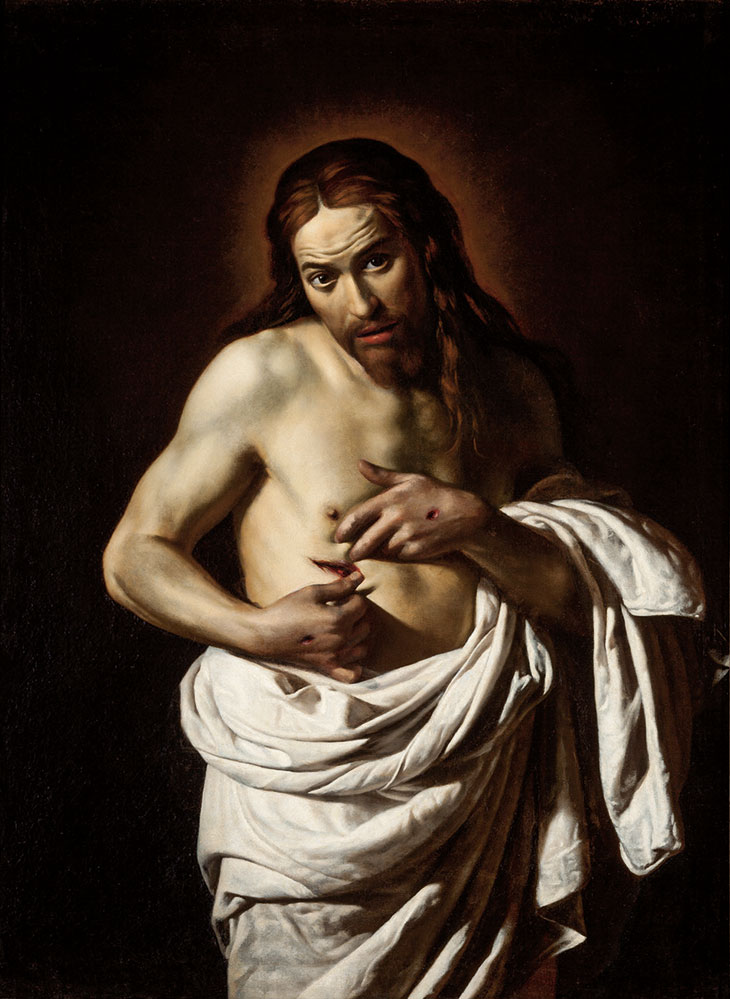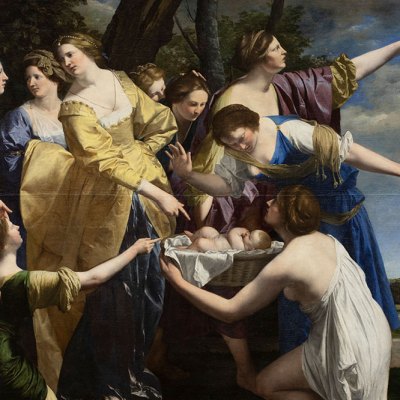The tension between the sublime and the terrible was something Romans at the turn of the 17th century faced on a daily basis: the home of the Pope, and the centre of Catholic authority, was at the same time rife with danger and riddled with licentiousness. The great baroque paintings and sculptures that emerged in the early decades of the seicento stage this push and pull between opposing forces: saints and classical figures shed their ethereal poise and became fleshy, violent, sexually charged. The chiaroscuro so characteristic of painting from the period was not just a pictorial technique: blending luminosity and darkness, it became a vision of the human condition.
‘Caravaggio–Bernini: Baroque in Rome’ at the Rijksmuseum, which has travelled from the Kunsthistorisches Museum in Vienna, is concerned not just with the two title names but also with the origins of the baroque, which it explores through a study of emotions (affetti). These were integral to the style as a whole: in painting, sculpture, and music, artists were concerned with conveying human emotion through gestures and expressions. Indeed, when in Vienna, the title of the exhibition, ‘Caravaggio–Bernini: the discovery of emotions’, particularly reflected this. Though the change in title suggests a shift in focus, the rooms are divided according to these doctrines of affetti using contemporary artistic vocabulary, such as ‘Meraviglia & Stupore’ (wonder and amazement), ‘Orrore & Terribilità’ (horror and terror), ‘Passione & Compassione’ (passion and compassion). It places joy, pain, fear, expectation and resignation side by side, a visceral plunge into the depths of human experience.
Mary Magdalene in Ecstasy (c. 1620/25 or c. 1630/35), Artemisia Gentileschi. Private collection. Photo: Saint Louis Art Museum

The exhibition itself provides a calm, spacious environment in which to take in all this excess. Each room is brightly lit and displays only a small number of works, some of which are hung on temporary walls placed at various angles to create intimate viewing spaces between them. It shows great confidence in the pieces in question, and with good reason. Nothing is wasted in the display – every work offers something distinctive and dazzling, and together they combine into a compelling narrative – and nor is it in the exhibition design: for the designers, Studio Formafantasma, sustainability is key. The backing fabrics used in hanging the paintings have been tailored in size and shape so they can be donated to a local fashion school when the exhibition is over and the glass cases have been reused from previous exhibitions.
The route begins with the emotions of wonder and amazement, represented by a single work each from the two headline artists: Bernini’s petrified Medusa (1638–40) and Caravaggio’s enraptured Narcissus (c. 1600). Narcissus is as mesmerising for the viewer as for the subject, and Medusa’s desperate gaze is so lifelike as to give the impression she could turn you into the very stone she is herself made of.
Narcissus (c. 1600), Michelangelo Merisi da Caravaggio. Photo: Gallerie Nazionali d’Arte Antica – Bibliotheca Hertziana, Max Planck Institute for Art History/Enrico Fontolan

Each of the following rooms displays several iterations of the same stories, allowing us to compare artists and style through this influential period: in the section on horror and terror we see Carlo Saraceni’s serene Judith calmly raise the still-screaming head of Holofernes (c. 1610), beside Orazio Gentileschi’s interpretation from c. 1608/09 of Judith and her maid gazing off canvas, alerted by something out of our sight. Images of decapitation accumulate: in Orazio Borgianni’s exceptionally violent David and Goliath (c. 1605/10), the young warrior battles to saw off the head of his vanquished foe, who looks out at the viewer consumed with pain; next to it, Tanzio da Varallo’s rendering of the same story from c. 1620 is far less aggressive, but no less arresting, as it shows a remarkably muscular David looking out defiantly at the viewer, the giant’s head in one hand, and his weapon in the other.
Elsewhere, in a section on visions, we see iterations of The Incredulity of St Thomas by Hendrick ter Brugghen (c. 1622) and Mattia Preti (c. 1656/60), with Spadarino’s extraordinary Christ Displaying his Wounds (c. 1625–35): the saint and Christ touch and open the wound with varying degrees of invasiveness and exploration. Two Mary Magdalenes in the same room – by Artemisia Gentileschi and Louis Finson (after Caravaggio) – provide further contrasts. Finson’s sexualised portrayal from 1613 has Mary’s lips and eyes slightly parted, and her dress tantalisingly revealing just a little too much flesh. Artemisia’s Mary (c. 1620/25 or c. 1630/35) lies back, but her ecstasy is of a transcendent kind, and she remains wholly unaware of the viewer’s gaze. Displaying the works in this way highlights the fact that they were created in dialogue, not in isolation.
Christ Displaying his Wounds (c. 1625–35), Giovanni Antonio Galli, called Spadarino. Perth Museum and Art Gallery & Kinross Council

While the names of Bernini and Caravaggio are the crowd-pullers, the exhibition reminds us continually that the story of the baroque cannot be reduced to these two individuals – and indeed, it is the lesser-known figures who consistently steal the show. Alessandro Algardi’s delicate sculpture Eros and Anteros (1630) is a tender and intimate rendering of the competition between earthly and erotic love; Tanzio da Varallo’s St Sebastian Tended by the Widow Irene and an Angel (c. 1615/25) depicts a more vividly realistic removal of the saint’s arrows than is often afforded to the subject. Francesco Mochi’s sculpture St Veronica (1631) is full of motion and life; as she runs to tell of Christ’s resurrection, her clothes billow behind her, revealing the imprint of the saviour’s face on the cloth. This copper piece is a to-scale modello for the far larger marble statue at St Peter’s in Rome, and is mesmerising in its detail and vitality.
This remarkable gathering of works is a feast for the senses and gives an exhilarating account of the birth of a groundbreaking artistic style. Beyond the masters name-checked in the title, it is a celebration of Roman art between 1600 and 1640, and the energy and contest of the moment that the exhibition brings so thrillingly to life.
‘Caravaggio–Bernini: Baroque in Rome’ is at the Rijksmuseum, Amsterdam, until 13 September (exhibition dates extended).



